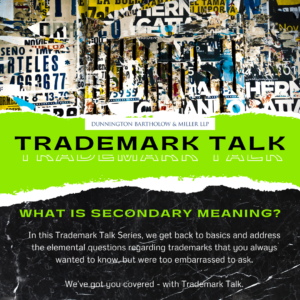 Secondary meaning is a critical concept in trademark law. It enables descriptive or non-descriptive marks to receive protection when consumers associate the mark with a particular source, such as a specific company, rather than just the product or service that it describes. In many instances, a descriptive mark can become powerful source identifier once it has obtained secondary meaning.
Secondary meaning is a critical concept in trademark law. It enables descriptive or non-descriptive marks to receive protection when consumers associate the mark with a particular source, such as a specific company, rather than just the product or service that it describes. In many instances, a descriptive mark can become powerful source identifier once it has obtained secondary meaning.
Under the Lanham Act, trademarks are categorized based on their inherent distinctiveness. This will directly impact their eligibility for protection. There are four broad categories of trademarks: generic, descriptive, suggestive, and arbitrary or fanciful. Generic marks are terms that refer to the general category or class of a product or service. For example, some of these terms include “t-shirts” or “computers.” Generic terms cannot be trademarked because they are common descriptors that must remain available for public use. Descriptive marks are terms that directly communicate details about the product’s ingredients, qualities, or characteristics and can only receive trademark protection if they have gained a secondary meaning that associates them with a particular source. Suggestive Marks suggest a quality or feature of a product but requires a consumer to use their imagination or thought to make the connection. Some examples include “The North Face” and “CITIBANK.” Suggestive marks are inherently distinctive and automatically receive protection under the Lanham Act without proof of secondary meaning. Arbitrary or Fanciful Marks are terms that have no inherent connection to the product or service. For example, “Apple” for computers or “Starbucks” for coffee. These marks are considered inherently distinctive and are eligible for protection without proof of secondary meaning.
Secondary meaning applies primarily to descriptive marks that have not initially been distinctive enough to qualify for trademark protection. Under the doctrine of secondary meaning, a descriptive mark can acquire distinctiveness over time if the relevant public begins to associate the mark exclusively with a particular source. In essence, a descriptive mark that has achieved secondary meaning functions as an indicator of origin, rather than only describing a product’s characteristics. While secondary meaning is not a requirement for suggestive, arbitrary, or fanciful marks, it is still at the core of their protection.
To establish secondary meaning, a business must demonstrate that its descriptive mark has become recognized by consumers as a source identifier. There are several key factors that will be assessed in order to determine whether a descriptive mark has achieved secondary meaning. These factors include:
- Length and Consistency of Use: The longer a mark has been used and the more consistently it has been used in commerce, the stronger the case will be for acquiring secondary meaning. Some courts consider five years of exclusive and continuous use as sufficient, but this varies by industry and jurisdiction. For example, the term “Holiday Inn” initially described a type of lodging but through years of consistent use and brand development, it has become associated exclusively with the Holiday Inn hotel chain.
- Advertising and Promotional Efforts: The extent and scope of advertising that specifically emphasizes the mark’s association with a business can contribute to the development of secondary meaning. Significant investments in marketing and advertising, especially when the mark is prominently featured, strengthen the connection between the mark and the business.
- Consumer Recognition: Evidence of consumer recognition is key to proving secondary meaning. Consumer surveys, feedback, and media references that show the public associates the mark with a specific source can be compelling when trying to acquire secondary meaning. Surveys will typically ask whether consumers associate a claimed trademark with one or more companies.
- Sales Success: A mark that is linked to a product or service that has enjoyed substantial sales may be seen as having acquired secondary meaning. High sales volumes, especially over extended periods, can indicate that consumers recognize the mark as identifying a particular source rather than simply describing the product.
- Unsolicited Media Coverage: Independent references to the mark in media or press coverage can also be helpful in demonstrating that the public has come to recognize the mark as a source identifier.
- Evidence of Copying: If competitors intentionally copy or attempt to imitate a mark, it can suggest that the mark has become associated with a specific source in the minds of consumers. Courts may use this as circumstantial evidence that the mark has developed secondary meaning.
To give an example, in United States Patent and Trademark Office v. Booking.com (2020), the U.S. Supreme Court held that a generic term combined with a top level domain (such as .com) is not automatically generic. Such a mark may qualify for trademark protection if consumers perceive it as identifying a specific source. In this instance, consumer perception was a key factor in identifying whether the mark was generic. The case illustrated that Booking.com had acquired secondary meaning because consumers recognized it as a brand associated with a specific company rather than as a general term for booking services. As a result, Booking.com was eligible for trademark protection.
Secondary meaning will play a critical role in transforming descriptive or generic terms into a protectable trademark. Assessing the key factors mentioned above will help establish if there is secondary meaning to a mark.
Questions about trade dress or trademarks? Contact our Trademark Practice Group Chair, Olivera Medenica, at [email protected].


